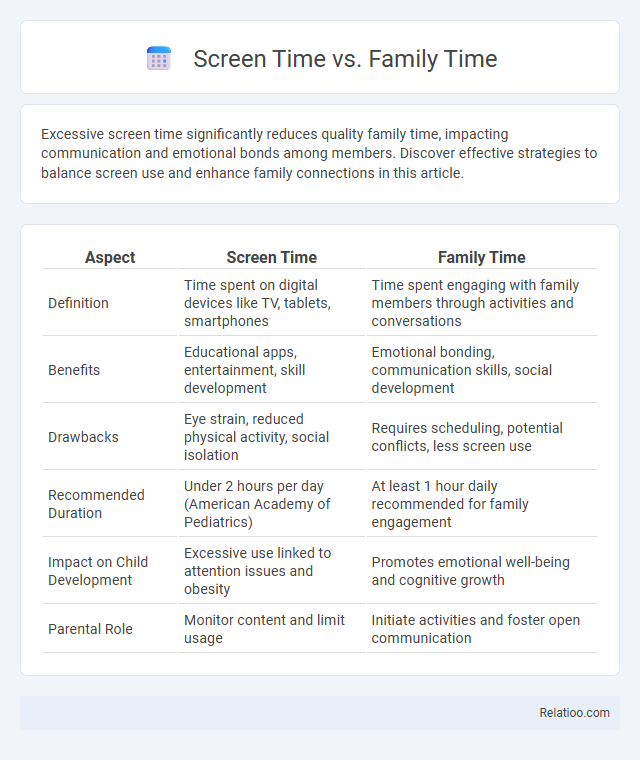Excessive screen time significantly reduces quality family time, impacting communication and emotional bonds among members. Discover effective strategies to balance screen use and enhance family connections in this article.
Table of Comparison
| Aspect | Screen Time | Family Time |
|---|---|---|
| Definition | Time spent on digital devices like TV, tablets, smartphones | Time spent engaging with family members through activities and conversations |
| Benefits | Educational apps, entertainment, skill development | Emotional bonding, communication skills, social development |
| Drawbacks | Eye strain, reduced physical activity, social isolation | Requires scheduling, potential conflicts, less screen use |
| Recommended Duration | Under 2 hours per day (American Academy of Pediatrics) | At least 1 hour daily recommended for family engagement |
| Impact on Child Development | Excessive use linked to attention issues and obesity | Promotes emotional well-being and cognitive growth |
| Parental Role | Monitor content and limit usage | Initiate activities and foster open communication |
Understanding Screen Time: Definitions and Trends
Screen time refers to the duration spent on devices like smartphones, tablets, computers, and televisions, encompassing activities such as browsing, gaming, and streaming. Family time focuses on in-person interactions that foster emotional bonding and communication, often diminished by excessive screen use. Understanding these definitions helps you balance digital engagement with meaningful family connections, reflecting growing trends in screen dependency and the need for mindful usage.
The Importance of Quality Family Time
Balancing screen time and family time is crucial for fostering strong relationships and emotional well-being. Quality family time involves meaningful interactions, such as shared meals, conversations, and activities that strengthen bonds beyond digital distractions. Prioritizing these moments helps reduce stress, enhance communication, and create lasting memories for you and your loved ones.
Impact of Excessive Screen Time on Family Relationships
Excessive screen time significantly disrupts family relationships by reducing face-to-face interactions and diminishing the quality of shared experiences. Your family members may feel neglected or emotionally disconnected when screens dominate daily routines, leading to misunderstandings and weakened bonds. Balancing screen time with meaningful family engagement is essential to foster stronger communication and emotional support within the household.
Benefits of Reducing Screen Time for Children
Reducing screen time for children enhances family interactions by fostering stronger emotional bonds and improving communication skills. Limiting device use also promotes better physical health, including improved sleep patterns and increased physical activity. By prioritizing family time over screen time, your child develops essential social skills and a balanced lifestyle that supports overall well-being.
How Screens Disrupt Parent-Child Communication
Excessive screen time significantly disrupts parent-child communication by reducing opportunities for meaningful interactions and emotional bonding, which are crucial for child development. Studies show that children with high screen exposure exhibit lower verbal skills and increased behavioral issues due to diminished face-to-face engagement. Prioritizing family time without screens fosters better communication, strengthens relationships, and enhances social and cognitive growth in children.
Strategies for Balancing Screen Time and Family Interaction
Establishing clear boundaries such as designated screen-free zones and scheduled family activities promotes a healthy balance between screen time and family interaction. Utilizing parental controls and apps that limit device usage encourages mindful technology engagement, enhancing quality time with loved ones. Prioritizing open communication about screen habits fosters mutual understanding and strengthens family connections.
Setting Healthy Digital Boundaries at Home
Establishing healthy digital boundaries at home balances screen time with meaningful family interactions, promoting emotional well-being and stronger relationships. Limiting daily screen use to recommended guidelines--typically no more than 2 hours for children--and creating tech-free zones during meals or family activities encourages presence and engagement. Consistent routines that prioritize family time over excessive device use foster communication, attentiveness, and a supportive home environment.
Creative Alternatives to Screen-Based Entertainment
Encouraging activities like outdoor play, board games, and hands-on crafts offers engaging alternatives to excessive screen time, promoting family bonding and creativity. These interactive experiences enhance cognitive development and strengthen relationships while reducing digital fatigue. Prioritizing nature exploration and storytelling fosters imaginative skills and emotional connection beyond digital devices.
Navigating Technology Together as a Family
Balancing screen time and family time involves setting clear boundaries and fostering open communication about technology use. Engaging in shared activities like co-watching educational content or playing interactive games strengthens family bonds while promoting responsible screen habits. Establishing tech-free zones or times encourages meaningful face-to-face interactions and helps families navigate digital distractions together.
Building a Screen-Conscious Family Culture
Balancing screen time and family time is crucial for fostering a healthy, screen-conscious family culture that supports meaningful connections and well-being. Setting clear boundaries around device usage encourages your family to engage in quality interactions, promoting emotional bonds and reducing digital distractions. Implement family routines that prioritize screen-free moments, enabling your loved ones to develop mindfulness and mutual respect in a technology-driven world.

Infographic: Screen time vs Family time
 relatioo.com
relatioo.com